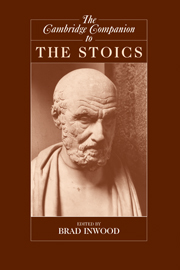Book contents
- Frontmatter
- Introduction
- 1 The School, from Zeno to Arius Didymus
- 2 The School in the Roman Imperial Period
- 3 Stoic Epistemology
- 4 Logic
- 5 Stoic Natural Philosophy (Physics and Cosmology)
- 6 Stoic Theology
- 7 Stoic Determinism
- 8 Stoic Metaphysics
- 9 Stoic Ethics
- 10 Stoic Moral Psychology
- 11 Stoicism and Medicine
- 12 The Stoic Contribution to Traditional Grammar
- 13 The Stoics and the Astronomical Sciences
- 14 Stoic Naturalism and Its Critics
- 15 Stoicism in the Philosophical Tradition
- Bibliography
- List of Primary Works
- Index
2 - The School in the Roman Imperial Period
Published online by Cambridge University Press: 28 May 2006
- Frontmatter
- Introduction
- 1 The School, from Zeno to Arius Didymus
- 2 The School in the Roman Imperial Period
- 3 Stoic Epistemology
- 4 Logic
- 5 Stoic Natural Philosophy (Physics and Cosmology)
- 6 Stoic Theology
- 7 Stoic Determinism
- 8 Stoic Metaphysics
- 9 Stoic Ethics
- 10 Stoic Moral Psychology
- 11 Stoicism and Medicine
- 12 The Stoic Contribution to Traditional Grammar
- 13 The Stoics and the Astronomical Sciences
- 14 Stoic Naturalism and Its Critics
- 15 Stoicism in the Philosophical Tradition
- Bibliography
- List of Primary Works
- Index
Summary
THE STEREOTYPE
According to a stereotypical view, Stoicism in the period of the Roman Empire was philosophically uncreative. The 'school' had an ill-defined institutional status and there was a good deal of eclecticism and merging of different philosophies. The dominant theme was ethics, and the main surviving works consist of exercises in practical moralising based on ideas mapped out centuries before. Unsurprisingly, in the later part of this period, Stoicism was replaced as a living philosophy by a revived Platonism and by a form of Christianity that was increasingly more sophisticated and theoretically aware.
Like all stereotypes, this one contains an element of truth; but it obscures important respects in which Stoicism continued as an active philosophical force for at least the first two centuries a.d. Although there was no institutional ‘school’ as there was in the Hellenistic Age, there were numerous Stoic teachers, and the distinctive three-part Stoic educational curriculum was maintained, with important work continuing in all three areas (i.e., logic, ethics, and physics). As well as being the dominant philosophical movement in the period, Stoicism was also strongly embedded in Greco-Roman culture and, to some extent, in political life, and the ideal of living a properly Stoic life remained powerful. In the third and fourth centuries a.d. and later, Neoplatonic and Christian writers built on key Stoic ideas and absorbed them into their systems.
- Type
- Chapter
- Information
- The Cambridge Companion to the Stoics , pp. 33 - 58Publisher: Cambridge University PressPrint publication year: 2003
- 58
- Cited by



